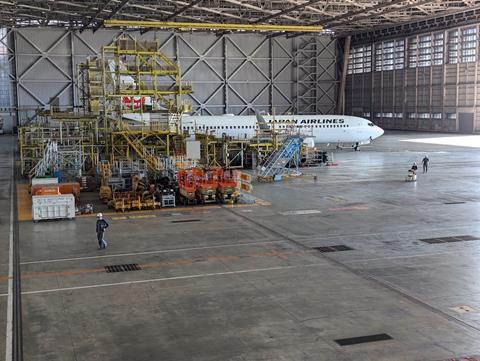The head of the Japan Airline’s MRO unit, JAL Engineering, feels that that supply chain issues have become structural, and that the company has a role to play in boosting the country’s domestic aerospace supply chain.
When asked to detail specific issues with the MRO supply chain, Koimai Takaskhi, the executive officer and vice president of JAL Engineering, says they are too many to list.

“We think this kind of situation will continue for a very long time,” says Koimai, speaking with FlightGlobal at JAL Engineering’s office near Haneda airport.
“We must recognise it is the new standard. We must prepare for acting correctly with this new standard, and I think one of the answers is building up the supply chain system in Japan.”
JAL Engineering is a dominant force in Japan’s MRO scene, with some 4,600 employees supporting JAL’s diverse aircraft fleet. The company performs line maintenance at airports across the country and conducts heavy checks domestically. It also sends JAL aircraft to oversees MRO providers such as HAECO.
Koimai observes that Japan is very strong in other industries, such as automobile manufacturing and electronics, producing high quality products. He feels that language issues and certification could present a challenge for such companies to enter aerospace, but that JAL Engineering can use its aerospace know-how to help the development of a more robust local supply chain.
Moreover, he sees scope for conducting more component repair work domestically, as opposed to in Southeast Asia. While costs may be marginally higher than shipping parts overseas, turnaround times and quality will be better if the work is done locally.
Koimai also touched on JAL’s August agreement with Mitsubishi Heavy Industries to explore opportunities in aircraft MRO.
Discussions are still at an early stage, but one area he sees the pair working together is in MRO for smaller aircraft, such as regional jets and turboprops. He observes that MHI owns the MHI RJ Aviation Group (known as MHIRJ), the world’s biggest MRO provider for regional aircraft.
On challenge JAL Engineering faces – and one MRO executives globally will be familiar with – is getting young people interested in work that can involve long hours in difficult conditions.
“Young guys like to work in the office, a very clean place, not like working on hot days, cold days, rainy days, or even Christmas night,” he says. “They have to continue to study the aircraft a very long time, more than thirty years.”
Even so, Koimai says that the industry needs engineers and mechanics. He notes that the Japanese government – which faces a broader challenge owing to Japan’s aging population – is increasingly open to filling roles with workers from overseas.
Koimai notes that foreign workers from nations such as Mongolia, the Philippines, and Singapore are willing to take up aircraft engineering roles in Japan.


























